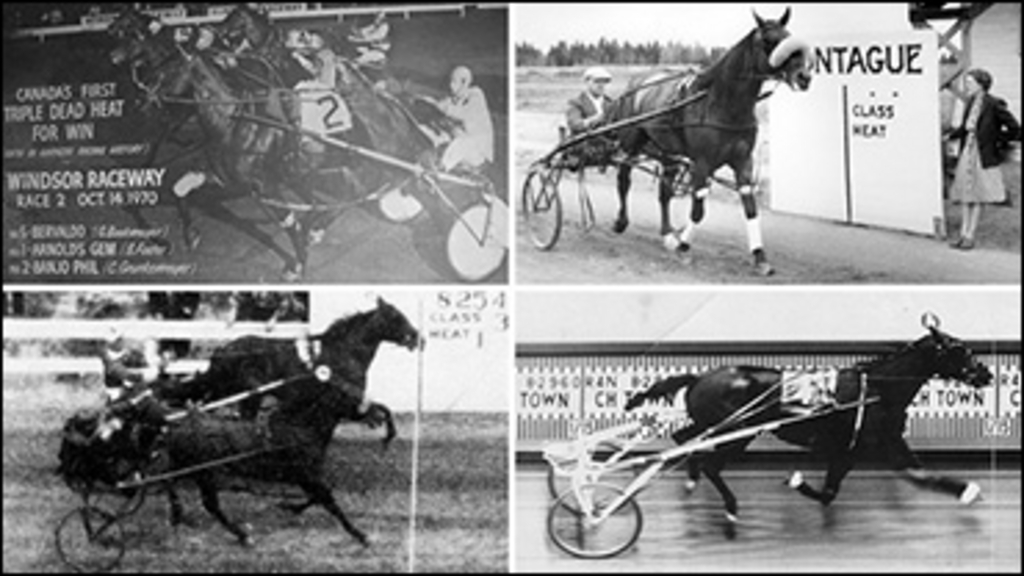
This week's edition of Rewind tells the story of the advent of the photo finish camera in Canadian harness racing. It was a great innovation when it first appeared and continues to be an indispensable part of the sport to this day. It is difficult to imagine holding racing without it. Thanks to the input of one of the followers of Rewind I am able to put this story together for the reading audience.
The use of photo finish camera technology in horse racing began back in the 1930's; first at several Thoroughbred tracks such as Hialeah, Santa Anita and Hawthorne. It eventually came into widespread use at harness tracks as well. The idea was conceived as far back as 1882 but the technology was not yet available. One ingenious photographer back then came up with the idea of putting a thin black thread across the track that could be "tripped" as the first horse crossed the finish line, thus setting off his camera!
When parimutuel betting became popular and began to provide the financial basis for harness racing, the need for the photo finish became essential. The use of the human eye even when employed by "committee or consensus" just was not sufficient. I recall reading the outcome of a 1940's race at Dufferin Park in Toronto where several placing judges saw the outcome of a race in different order. Apparently the number "7" was mistaken for "1" by multiple placing judges resulting in utter chaos.
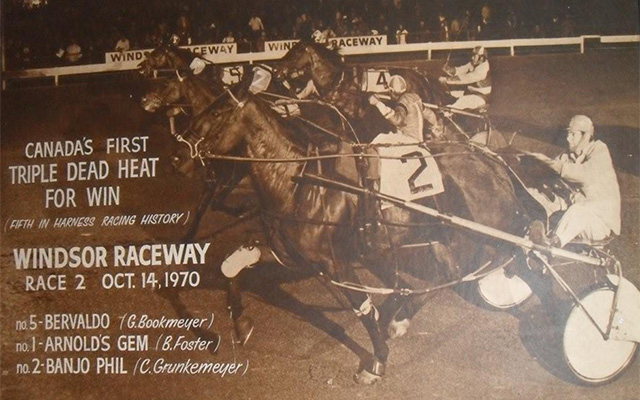
Canada's first official triple dead heat for win occurred at Windsor Raceway almost 50 years ago on October 14, 1970 and was recorded as the fifth in history. The photo finish camera could not separate three horses at the wire. They were Arnolds Gem driven by Bud Foster, Bervaldo piloted by Gerry Bookmyer and Banjo Phil in rein to Charlie Grunkemeyer. Oddly all drivers were U.S.-based but racing at a Canadian track. A large picture of the event hung in the upper level of the Windsor grandstand near the clubhouse entrance for many years. Shortly after this rare event occurred, a special handout was given to thousands of Windsor race goers as a commemorative reminder of this event.
Reportedly harness racing's first triple dead-heat for win occurred at Freehold Raceway in New Jersey on October 3, 1953. Oddly the three horses were all three-year-old fillies and each of their names began with the letter "P". The camera was unable to separate Patchover, Penny Maid and Payne Hal at the finish wire.
The Photo Finish Camera Is Introduced In Canada
Shortly after the conclusion of WWII around 1945, a couple of gentlemen who were seriously involved with harness racing in Prince Edward Island decided to tackle a long-standing problem and ultimately find a solution. All too often when racing was held at local tracks, two or more horses would reach the finish wire so closely that it was virtually impossible for the human eye to separate the participants. Judges who were often serving in a voluntary role were left with the task of assigning the order of finish based solely on what they saw with the naked eye.
Chances of hometown decisions and errors were always possible even with the best of officials. Owners, drivers and the betting public sometimes saw finishes different than the judges. I once heard a tale of yore that involved racing at the great old town of Strathroy, Ont. For many years race day organizer Harold Currie stood a popular sire named Corporal Lee, reportedly a horse he highly toted to one and all. Legend has it that if there was a close finish involving an offspring of his "Wonder Horse" and one not sired by him, guess who was likely to get the nod?
Colonel Dan MacKinnon, a legendary figure in the area and also the President of The Charlottetown Driving Park in 1945, was one of the individuals to tackle the issue of close calls. The other was a gentleman named Rupert Godfrey, a resident of Marshfield, P.E.I., who was a multi-talented man and considered to be something of a mechanical wizard. The two men thoroughly discussed the entire project and soon set out to find a solution.
In fairly short order Mr. Godfrey made the necessary arrangements and travelled to the U.S. to further study the equipment available and ultimately place orders for whatever was required. Through his untiring efforts the entire system was assembled, tested and became ready for the 1947 racing season. While the initial equipment was very satisfactory, the talented Mr. Godfrey continued to refine it and improve its capabilities.
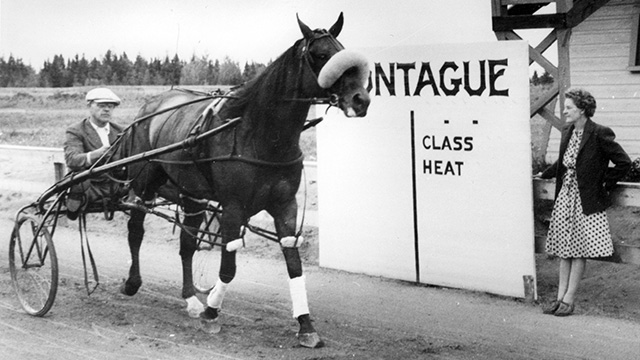
The above photo shows some preliminary work being done on the photo finish setup at the Montague track by Dr. Preston McIntyre with his wife Alice assisting. This was just prior to its introduction in July of 1947. The sign served as a backdrop to identify the race number, date and other pertinent information.
It was an historic day for Maritime harness racing on July 9, 1947 when the photo finish camera was first put into use at the small town track at Montague, P.E.I., then under the ownership of George MacIntyre. It soon came into serious use that day as two horses came to the wire at what appeared to be the exact same moment in the Invitational event. They were so close that the judges for the first time ever called for "a photo" to be examined. It was of course a happening that would soon occur with regularity.
The two horses were Anti Aircraft, owned by C. H. Murray of Horton River and driven by Willard Kelly, and the other a mare named Kavalo driven by Roy 'Trooper' Barnett for owner P. MacCormac of Charlottetown. A close examination of the photo immediately proved its worth and indeed Anti Aircraft was declared the winner. The new system was an instant success and was soon put into use at a number of Maritime tracks during that 1947 season. After its debut at Montague it was also used at Covehead, Riverside, Moncton and Charlottetown, a total of 17 race days. It was the start of a new trend that spread throughout the Maritimes. On June 28, 1949 it was first used at a night-time meeting at CDP and the same equipment was used the very next day at Truro, N.S.
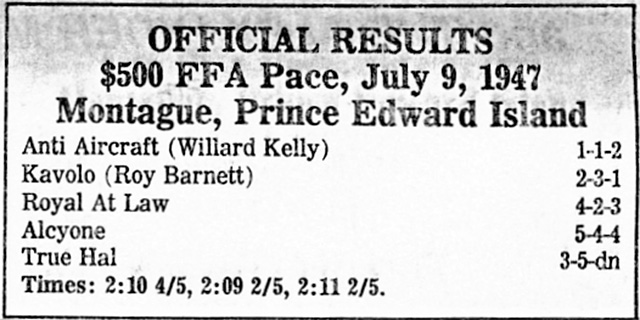
Results of the first ever race to be verified by the use of the photo finish camera at a Canadian track
-wins-in-phto-over-Billy-Mcvay-(Walter-Craig)-Montague-1948-photo-finish-640px.jpg)
A close finish during the 1948 season at Montague with the results shown above.
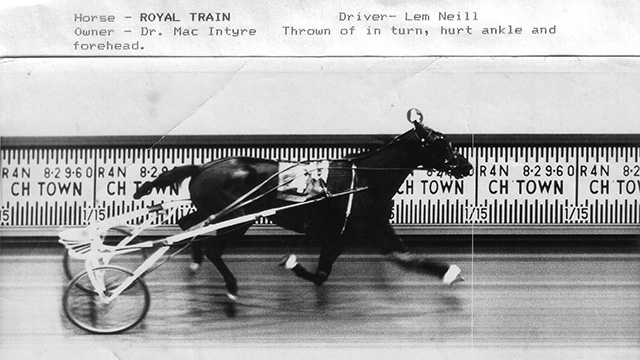
This 1960 photo taken at Charlottetown shows a driverless horse finishing a mile. The horse, Royal Train owned by Dr. MacIntyre, lost driver Lem Neill. He received injuries to his ankle and forehead but continued on to have his picture taken by the photo finish camera.
While the introduction of the photo finish camera was an instant success and acclaimed by all it was not always available at each and every race meeting. Harness racing was held for decades at small town tracks which still depended on the judges at the finish wire making the final placings. Thank goodness for this amazing and essential piece of equipment that has been the sole arbiter of the finish of probably millions of races.
A special thank you goes out to Mr. Jerry McCabe, a great Maritime racing historian for supplying much of the material used in today's story. Jerry has done a wonderful job in collecting a lot of very interesting old pictures and other material pertaining to the history of harness racing in the region. He has been very generous in sharing it and I thank him on behalf of all of the Rewind readers.
Quote For The Week - "A dog is judged by the company he keeps, a woman by the company she leaves."
Who Is It?
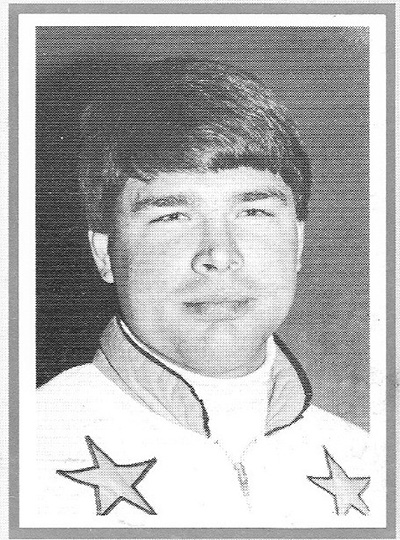
Can you correctly identify the gentleman pictured above? What award did he win in 1986?
Who Else Is It?
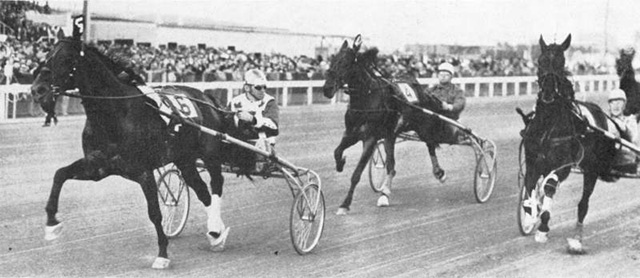
Can you name any or all of the drivers in the finish of this 1964 race at Blue Bonnets in Montreal. A pretty good field of trotters head for the wire (Harness Horse photo)


This week's pictures were
This week's pictures were both identified by our "experts". In the top photo was a then 27-year-old Gary Kingshott who was the 1986 OJC Non-driving trainer-of-the - Year. In the lower photo at Blue Bonnets in May 1964 was Sprite Kid driven by Roger White in the lead, Choir Boy second at the rail with Keith Waples and third was Van Counsel handled by Claude Watters. (Garth has a pretty sharp eye) This was the Invitational Trot with a purse of $6,000 and the mile was recorded in 2:04 even. Your participation is always appreciated.
Roger White; Frank Baise?;
Roger White; Frank Baise?; Keith Waples
Who is it? Gary Kingshott.
Who is it? Gary Kingshott. Who else is it? Roger White first, Keith Waples second, Claude Watters third. The photo camera solved a lot of problems for Standardbred horse racing.
That is Gary Kingshott not
That is Gary Kingshott not sure what award, I'm guessing leading trainer. the drivers in the photo are Roger White, Keith Waples and Del Mctavish.
First photo is Gary Kingshott
First photo is Gary Kingshott